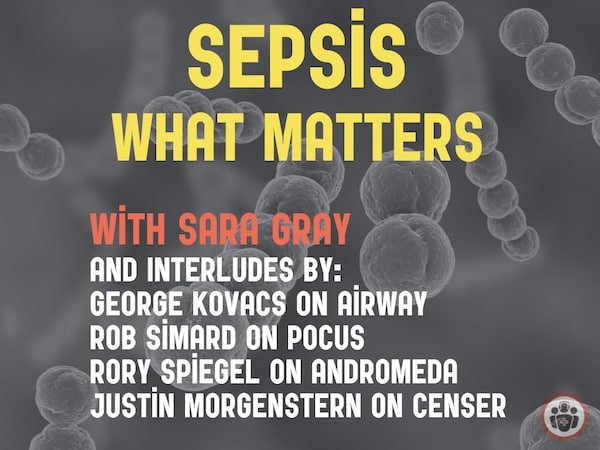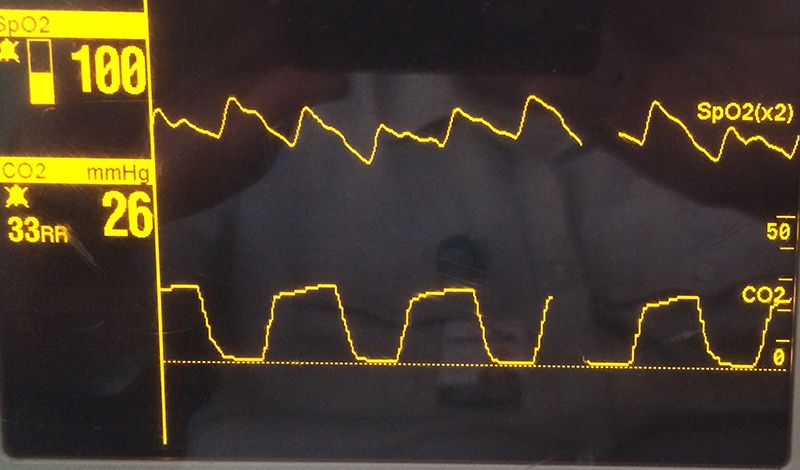low end tidal co2 sepsis
This can be seen in a number of other conditions. In MAP group FR began when MAP at most 100 mmHg.

Jems Using Etco2 To Detect Sepsis Youtube
End tidal CO2 for sepsis alert.
. A low end-tidal CO2 may indicate poor perfusion hypovolemia or sepsis. End Tidal CO2 monitoring is essential as it is the fastest indicator of ventilatory compromise. Prehospital recognition of severe sepsis.
Hunter CL Silvestri S Dean M et al. ETCO2 emergency department monitoring and critical. Goal is 10 mmHg during CPR.
Am J Emerg Med. After intubation if ETCO 2. Although the normal range for CO2 should be between 35-45mmHg CO2 monitoring gives healthcare providers a lot more insight into what is going on with a patients condition.
Additionally low end-tidal carbon dioxide ETCO 2 levels have been associated with lactic acidosis organ dysfunction and mortality in ED patients with suspected sepsis. On the other hand a high CO2 reading may indicate airway narrowing. There is more than one version of this tool.
There is an inverse relationship between serum lactate levels and end-tidal CO2 ETCO2. What is end-tidal CO2 etCO2. Low end tidal co2 range.
To determine the utility of a prehospital sepsis screening protocol utilizing systemic inflammatory response syndrome SIRS criteria and end-tidal carbon dioxide ETCO2. Cecal ligation and puncture CLP was used to cause severe sepsis in male SpragueDawley rats. 25 EtCO2 correlates well with cardiac output and rapidly drops to zero at CPA onset.
ETCO2 levels have been shown to be an accurate predictor of mortality in patients with severe sepsis and septic shock 89 and Hunter et al found that ETCO2 levels less than 25 mm Hg are strongly associated. A low end-tidal CO2 may indicate poor perfusion hypovolemia or sepsis. Also called capnometry or capnography this noninvasive technique provides.
End-tidal carbon dioxide cannot be used to rule out severe injury in. Hunter CL Silvestri S Ralls G Stone A Walker A Papa L. Use CXR and ABG in septic patients with acute respiratory failure to diagnose ARDS 2B.
Hunter CL Silvestri S Dean M et al. In this study the aim was to review the applications of end-tidal carbon dioxide ETCO2 monitoring in emergency department multiple databases were comprehensively searched with combination of following keywords. We conducted a prospective cohort study among sepsis alerts activated by emergency medical services during a 12 month period after the initiation of a new sepsis screening protocol.
End-tidal carbon dioxide ETco 2 monitoring provides valuable information about CO 2 production and clearance ventilation. Total pressure of a gas is the sum of the partial pressures of the gas Expired CO2 measured PetCO2 mmHg in waveform Percentage Normal Levels. Evidence suggests a persistently low ETco 2 value and a widened Paco 2-to-ETco 2 gradient during CPR are associated with poor outcomes.
There are four groups in this study. Asplin BR White RD. Therefore correlation between the end tidal CO2 and an ABGVBG measurement is needed to confirm the diagnosis of hypocapnia.
Discover the key facts in understanding this technology and its implications in clinical practice. These waste products then accumulate in. Am J Emerg Med 2016.
Bhende MS Karasic DG Karasic RB. A low end-tidal CO2 may indicate poor perfusion hypovolemia or sepsis. Prehospital identification and initiation of therapy for severe sepsis may.
However this may also be caused by pulmonary dysfunction with an increase in dead space volume. As lactate rises carbon dioxide levels fall. End-tidal carbon dioxide is associated with lactate levels and mortality in emergency department patients with suspected sepsis.
Low pre-treatment end-tidal CO2 predicts dropout from cognitive-behavioral therapy for anxiety and related disorders. End-Tidal CO2 monitors do exactly as the name implies they monitor CO2 in the air that we breathe out. Low EtCO 2 with other signs of shock indicates poor systemic perfusion which can be caused by hypovolemia sepsis or dysrhythmias.
Throughout the resuscitation end-tidal CO 2 was consistently in the 28-36 mmHg range during VFCPR. Sham n 5 CLP n 10 end-tidal carbon dioxide ETCO 2 n 10 and mean arterial pressure MAP n 10In ETCO 2 group fluid resuscitation FR began when ETCO 2 at most 25 mmHg. NaHC03 will increase EtCO2 because it splits into CO2 and H20 So if rises after NaHCO3 do.
End-Tidal Carbon Dioxide Monitoring. 11172009 4 Measuring End Tidal CO2 Daltons Law. More Than Just a Number.
Development and validation of a novel EMS screening tool. Start date May 8 2016. End tidal CO2 revealing a substantially low CO2 measurement also suggests hypocapnia eg etCO2.
Therefore patients with severe sepsis may have an elevated respiratory rate with a low end-tidal CO2 reading. Where feasible ultrasound exam of lungs and heart may be used to narrow down the diagnosis. Cardiac output and end-tidal carbon dioxide.
A low end-tidal CO2 may indicate poor perfusion hypovolemia or sepsis. Capnograph is an indispensable tool for monitoring metabolic and respiratory function. In the TTM trial the end of TTM median tidal volume was 77 ml kg 1 predicted body weight 60 of patients had a tidal volume less than 8 ml kg 1 median PEEP was 77 cmH 2 O 6487 mean driving pressure was 146 cmH 2 O 43 and median FiO 2 was 035 030045.
In fact its commonly called the ventilation vital sign. A prehospital screening tool utilizing end-tidal carbon dioxide predicts sepsis and severe sepsis. The single center study was a prospective observational cohort study evaluating end-tidal carbon dioxide as a resuscitative end point for sepsis 8.
There are Capnometers which display a numeric reading of the CO2 Waveform Capnography which creates a graph of the CO2 as well as certain aspects about how the patient is breathing and. Polito CC Isakov A Yancey AH 2nd et al. Recommendations and suggestions on ventilatory support in patients with sepsis or septic shock in resource-limited settings with grading ARDS diagnosis.
Also called capnometry or capnography this noninvasive technique provides a breath-by-breath analysis and a continuous recording of ventilatory status.

Use End Tidal Carbon Dioxide To Diagnose Sepsis Jems Ems Emergency Medical Services Training Paramedic Emt News

Evidence Supports Using End Tidal Carbon Dioxide To Detect Prehospital Sepsis Jems Ems Emergency Medical Services Training Paramedic Emt News

Sepsis Management For The Nephrologist American Society Of Nephrology

Sepsis And Septic Shock Emergency Medicine Cases Em Cases Podcast

Pin On Educational Medical Diagrams

Sepsis Early Recognition And Treatment In Prehospital Setting Vital For Patient Outcomes Jems Ems Emergency Medical Services Training Paramedic Emt News

6 Useful Sepsis Assessment And Treatment Tips Capnoacademy Capnoacademy

How Capnography Can Be Used To Identify Sepsis

Exhaled End Tidal Carbon Dioxide As A Predictor Of Lactate And Pediatric Sepsis The American Journal Of Emergency Medicine

Evidence Supports Using End Tidal Carbon Dioxide To Detect Prehospital Sepsis Jems Ems Emergency Medical Services Training Paramedic Emt News

Icu One Pager Icu Nursing Icu Icu Nurse Critical Care

End Tidal Carbon Dioxide Is Associated With Mortality And Lactate In Patients With Suspected Sepsis The American Journal Of Emergency Medicine

The State Of Sepsis With Dr Karin Molander Sepsis Alliance Chair Elect Jvion

Caep Sepsis Treatment Checklist Download Table

Two Hours Of In Vivo Lung Perfusion Improves Lung Function In Sepsis Induced Acute Respiratory Distress Syndrome Seminars In Thoracic And Cardiovascular Surgery